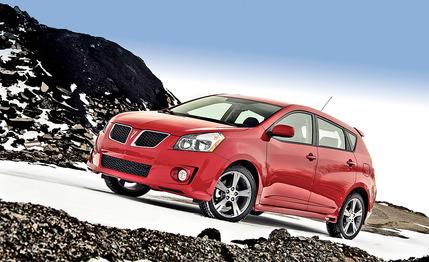 Short Take Road Test
Short Take Road Test
It’s unlikely that Pontiac, an Ottawa Indian chief, ever expected a GM division to be named after him, although he might have had good vibes about the red arrowhead that serves as its logo. He wouldn’t have known what a vibe was, but that’s okay, because he wouldn’t have known what a matrix was, either. In this case, a Toyota Matrix is the Pontiac Vibe’s progenitor and second-gen mechanical twin, both descended from the latest Corolla. Corolla, of course, was Chief Pontiac’s third mistress.
There are three Vibe-rations on tap: the base 1.8-liter (starting at $15,895), an all-wheel-drive version ($19,495), and the GT we sampled here ($19,895). The AWD and the GT benefit from a 158-horse, 2.4-liter four, lending them a 26-hp edge over the starter kit.
The GT is notable for its stiffer suspension, chrome strut-tower brace, and aggressive 18-inch rubber. Stability control, ABS, and traction control are standard.
What you first notice about the Vibe is that it is quiet and gratifyingly smooth at step-off, although it idles at so few revs—presumably to save fuel—that a few embarrassing stall-outs transpire before you get the hang of it. Power flows effortlessly from 2000 rpm to redline, but the engine becomes a tad raucous above 4500 revs, where your ear suggests an upshift. Full throttle in the lower gears reveals minor torque steer. With so few ponies in harness, why? Sixty mph comes in 7.9 seconds, 0.6 second behind, say, a Mazda 3 s Touring.
You sit high and upright in the Vibe, as if in a minivan. The IP and the center stack are simple and ergonomically bang on. The large HVAC controls can be operated while you’re wearing gloves, and the Toyota-derived wiper and signal stalks move with silky precision. The pedals are arrayed for heel-and-toeing, clutch takeup is predictable, and the manual five-speed moves from gate to gate with satisfactory heft and accuracy, although reverse is often hard to find.
In the hills, the GT’s ride is firm, occasionally choppy over truly scabrous tarmac. Body motions are masterfully controlled, and the platform feels reassuringly solid. With a tendency toward a small amount of lift-throttle oversteer, the Vibe’s tail can even be rotated. The GT’s chief drawback is its electric power steering, which is leaden and numb at all speeds. Strangely, the base Vibe’s rack was easier to spin at parking-lot speeds. Some engineers apparently still equate heaviness with sportiness.
The rear seats are vast and roomy. Fold them flat and you’re rewarded with 49 cubic feet of cargo space, and the floor is finished in easy-to-wipe-down plastic. With minor cursing, we stowed a bike back there. Plus, the right-front seatback folds flat, creating even more valuable space.
The Vibe is a practical and justifiable small wagon that will face the likes of the Dodge Caliber (which it will trounce) and five-door Mazda 3 (which it might not). But “GT,” in this case, stands less for “grand touring” than “general transport.” All the Vibe’s moves are admirable. None is spectacular. Result? Sensible shoes.